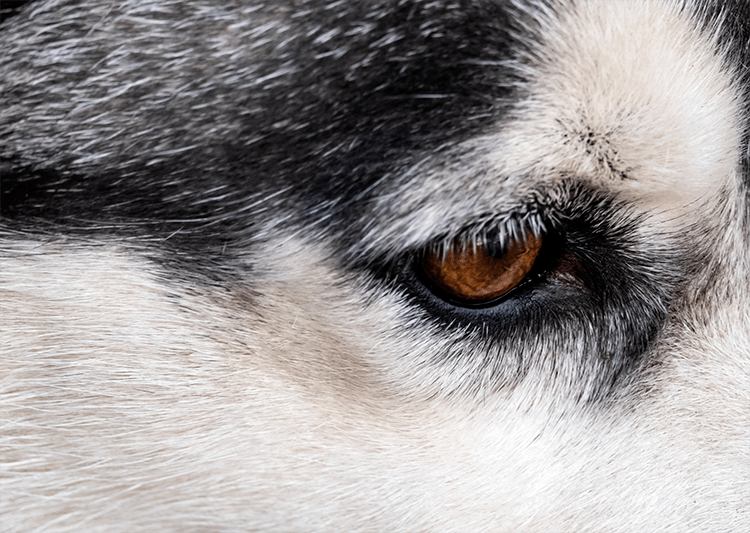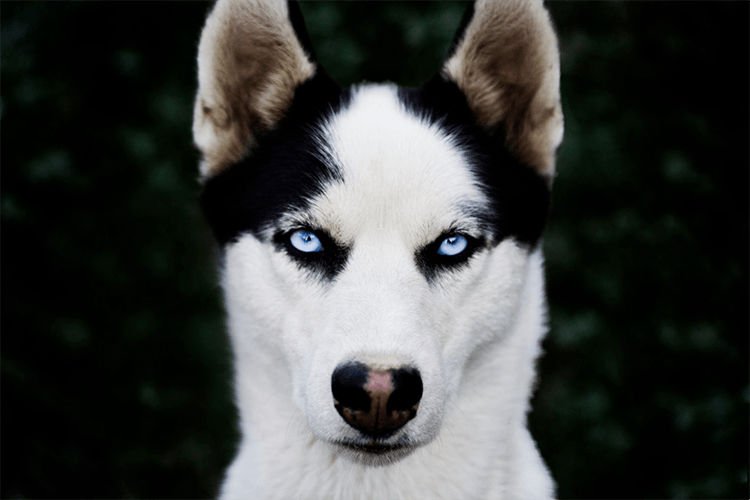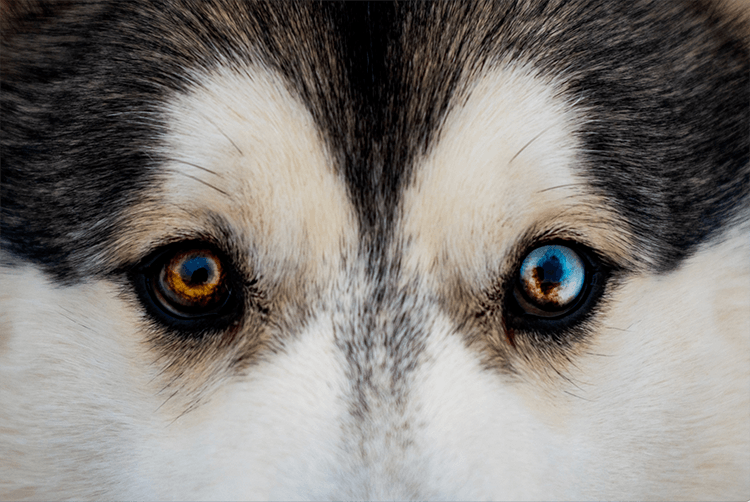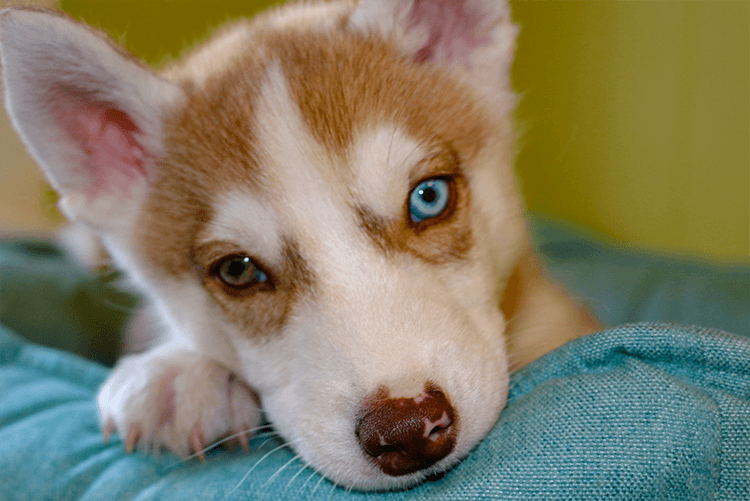Huskies are intelligent, outgoing, and friendly. They come in an array of different colors, and with their wolf-like appearance, anyone is bound to fall in love the moment they meet them. There are very distinct traits about huskies, but the most popular one is their eyes. What do must you know about huskies’ eyes?
Huskies’ eyes come in a variety of colors. They may have icy blue, brown, a blend of brown and icy blue (parti-colored) eyes, or bi-colored eyes, one eye brown or blue and another eye the opposite color. Both brown and blue eye colors are standard and do not represent any eye issues or illnesses.
Why is everyone so fascinated by a husky’s eyes, and why does it stand out more than other dog breeds? Read on and discover the exciting facts about husky eyes!
See also: our guide to husky markings
Husky Eyes: 8 Things You Need To Know
Huskies are independent, affectionate, alert, and hands-down the most beautiful dog breed. But that is not all they are known for. Huskies have very distinct and unique looks, similar to that of a wolf; however, their eyes enchant us.
Huskies are naturally born with glassy blue eyes and almond-shaped eyes. After eight weeks, 40 percent of huskies’ eyes stay blue, and 20 percent of huskies’ eyes switch to a blend of blue-brown or opposite-colored eyes (one blue and one brown). The remaining 40 percent of huskies have brown eyes.
What Are The Different Husky Eye Colors?
Here are a few interesting husky eye facts that are noteworthy if you have or want to own one of these bubbly doggies:
Brown Eyed Huskies

Pretty brown eyes that look like swirled chocolate! Huskies with brown eyes are not as breath-taking as huskies with blue eyes, but they still possess a sincere and enthralling look.
Before the American Kennel Club proved us all wrong, many people believed that huskies with brown eyes were not purebred; actually, huskies have an equal chance of having blue or brown eyes.
Your Husky can have a different shade of brown eyes ranging from hazelnut to chocolate brown.
Blue Eyed Huskies

Any dog with blue eyes seems to capture our attention. Blue-eyed huskies are typical, and if you own a husky with blue eyes, they are one of the 40 percent of huskies likely to have blue eyes.
The gorgeous aspect of their eyes is that they come in various shades of blue – from ocean blue to pale icy blue. A few huskies even have vivid blue eyes with a prominent ring of brown or black skin surrounding the parts of their eyes.
Remember, huskies originate from Siberia, which is located in Russia. Siberia is covered in snow, and huskies are used to the snowy environment. Over the years, this seemed to evolve to protect their eyes from sun rays radiating from the ice and snow.
Parti-Colored Eyed Huskies

A rare occurrence in huskies is parti-colored eyes. Their eyes are a blend of blue and brown, either in both eyes or one eye. The eyes can be an unequal amount of brown and blue or a swirl of both colors. About five percent of huskies have this eye feature. It is not anything to worry about; this occurrence is very rare.
Bi-Colored Eyed Huskies

Bi-colored-eyed huskies have one blue eye and one brown eye. It is rare; however more common than parti-colored eyes. Only around 10 to 15 percent of huskies have bi-colored eyes. There is no proof that bi-colored-eyed huskies have eye problems or illnesses, as this seems to worry owners.
What Are The Most Common Husky Eye Colors?
The most common eye colors in huskies are blue and brown. Bi-colored eyes are second in the row, followed by parti-colored eyes. There have been cases of huskies with these eyes colors, but it is estimated that only four to five percent of huskies have green or yellow eyes. Even rarer are huskies with green or yellowish eyes.
Why Do Some Huskies Have Blue Eyes?
Like all puppies, huskies are born with blue eyes and can change color as they grow up. This is because of the production of melanin pigment. Genes regulated in humans that determine if they have blue eyes are HERC2 and OCA2, but the gene for huskies is ALX4. ALX4 causes less melanin pigment in the huskies’ eyes, resulting in icy or ocean blue eyes. Blue eyes mean a mutated duplication near ALX4.
This gene is found on chromosome 18. Unlike humans, who have 46 chromosomes, dogs have 32 more chromosomes (78).
Why Do Some Huskies Have Brown Eyes?
Huskies have brown eyes due to high levels of melanin and the absence of the merle gene. It ranges from different shades of brown such as chocolate brown, hazel brown, or amber.
Why Do Some Huskies Have Parti-Colored Eyes?
The distribution and concentration of melanin regulate the opposite eye colors. The parti-colored eyes are a hereditary condition. Although rare, it is entirely normal for huskies to have swirls of blue and brown eyes.
Why Do Some Huskies Have Bi-Colored Eyes?
Bi-colored Huskies have one brown eye and one blue eye. A genetic mutation causes heterochromia and, as I mentioned before, is determined by the concentration and distribution of melanin.
What Eye Problems Can Huskies Develop?
A veterinary ophthalmologist usually diagnoses eye diseases and determines if the eye problems are hereditary or non-heredity. You may know that huskies are prone to hereditary eye diseases; despite their eye color.
To prevent the development of these diseases, the American College of Veterinary Ophthalmologist and Siberian Husky Club of America has put together a set of guidelines breeders can refer to avert hereditary eye diseases.
Only dogs with no eye issues should become breed parents.
If a husky exhibits no eye problems but is related to a dog with an eye disorder, they must be held back from breeding.
A certified AVCO veterinarian should examine a Siberian Husky before they are used for breeding. The examination is extensive and done throughout the year the Husky is used for breeding.
The three eye disorders your Siberian Husky may develop are:
Juvenile Or Hereditary Cataracts
Cataracts in huskies are found in the posterior region of the eye lens caused by a recessive gene. Juvenile cataracts are hereditary and can develop in huskies as early as three months old. The earlier you discover it, the better.
Your veterinarian can prescribe eye drops for your Husky at an early stage, but cataracts receive specific treatment depending on their stage. If the Husky turns blind, the veterinarian will undoubtedly suggest surgery.
Huskies have a great sense of smell and hearing, so you need not worry if they have vision problems. They can always rely on those two senses to guide them.
Progressive Retinal Atrophy
Huskies can lose their vision at five-month-old with Progressive Retinal Atrophy, making this the most serious eye defect. It affects the retina, which possesses two kinds of rods responsible for the dog’s vision. They start losing their night vision and daylight vision and ultimately become blind. The disease is hereditary and transmitted through the XX chromosome of a female husky. There is no successful or effective treatment for Progressive Retinal Atrophy.
Corneal Dystrophy
This eye issue affects the cornea or the outer part of the Husky’s eyeball. It is primarily female huskies infected with Corneal Dystrophy and young adult dogs.
Their eyes will turn hazy because of the lipid collection in the cornea.
A recessive gene once again causes the disease. Although no treatment is necessary because it does not influence the dog’s vision, I recommend taking your husky to a veterinary ophthalmologist for a check-up since it can lead to corneal ulceration.
Frequently Asked Questions About Husky Eyes
Here are a few additional questions that you might want answers to about a husky’s eyes:
Do Husky Eyes Stop Changing?
A husky’s eye color usually changes at five to eight weeks old. Sometimes it continues to change up until six months old. At 12 to 16 weeks, their eye color will stay the same, so their eye color can stop changing at 16 weeks.
What Is The Most Common Eye Defect In Huskies?
The most common hereditary defect among huskies is cataracts, followed by corneal dystrophy and progressive retinal atrophy.
Should I Take My Husky For Regular Eye Check-Ups?
It is essential to take your Husky for regular eye check-ups. Your husky must go for an eye screening annually until they reach seven to eight years old. The eye screening is not painful or uncomfortable for the dog, but they might squirm because you need to restrain them.
Can Huskies Have Red Eyes?
Many believe that huskies can have red eyes, but this is not true. The light can trick you into thinking their eyes are red, or it is their very visible red blood cells you see whenever they look directly into a light source.
Once it reaches its permanent eye color, there is no chance that the Husky will suddenly have its eyes change red.
If their eyes are red, you must take them to the veterinarian. They might have gotten hurt or acquired an eye disease such as uveitis, glaucoma, or corneal ulcers.
Why We Love Husky Eyes!
Huskies are great, family-friendly pets and one of the most beautiful dog breeds.
Their eyes make them unique. Huskies can have blue, brown, parti-colored (swirls of blue and brown), or bi-colored (heterochromia) eyes. Their distinct eye colors are typical and do not mean they have any eye illnesses. However, huskies are prone to hereditary eye diseases, especially cataracts. Luckily they can rely on their excellent sense of hearing and smell to lead them.
At around 16 weeks, your husky will have reached their permanent eye color, but it might change up to six months of age. You must take your Husky for yearly eye screening until they get seven or eight years old.
